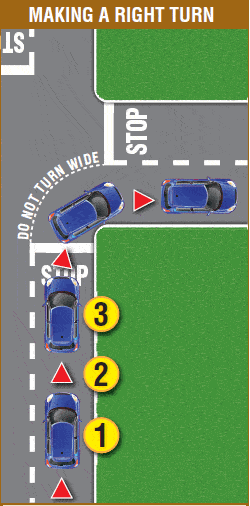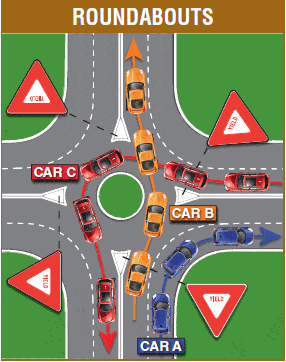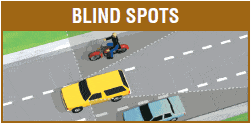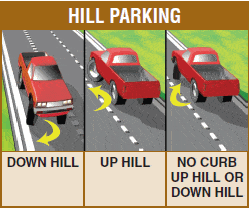Following are training guide from All Season:
Signalling to Other Drivers
Teach your teen how to signal for left and right turns, slow down, and stop. Have your teen demonstrate arm signals and electric turn signals as shown in the diagram. During the driving test, your teen must use the vehicle’s turn signal during the last 100 feet before turning. At highway speeds, it is best to signal at least five seconds before changing lanes.
Driving a “Stick”
A vehicle with an automatic transmission is recommended because it is easier to operate. If your teen has problems shifting, practice the steps below without releasing the parking brake. With the ignition off, have your teen:
- Depress the clutch to the floor. Hold it there.
- Practice shifting through all the gears.
- Practice until shifting is automatic.
- Practice pressing down the clutch pedal and shifting to a gear you have chosen. After shifting becomes easy, have your teen practice shifting in and out of first gear when stopping and starting.
Shifting into First Gear
- Place the gearshift into neutral.
- With the clutch firmly depressed and a foot on the brake pedal, start the engine.
- Release the parking brake.
- Move the gearshift lever from neutral to first gear.
- Let the clutch come up very slowly until it reaches the point at which the engine takes hold and begins to pull the vehicle forward.
- Move his/her foot from the brake to the gas pedal and press down gently.
- Slowly let the clutch pedal come up all the way.
Note: Do not allow your teen to push in the clutch and coast to a stop.
Backing Up the Vehicle
Practice on a wide residential street with little or no traffic, or in a parking lot with no obstacles or vehicles. Before starting to back up, have your teen turn his or her head to survey the area rather than relying just on the rearview and/or side mirrors, which may not show all hazards. Avoid backing around corners or sharp curves unless there is good visibility in all directions. If your teen seems to have problems backing, have him or her follow the steps below:
- Put left hand at the top of the steering wheel.
- Place foot on the brake.
- Shift to reverse.
- Check in all directions for traffic, children, animals, and objects in or moving toward his/her path.
- Release the parking brake.
- Place right hand on the back of the seat and look over right shoulder through the rear window.
- Release the foot brake slowly and apply the accelerator if needed — be ready to brake to control the speed of the vehicle.
- Occasionally look quickly to the left.
- Move slowly and avoid sudden movement of the steering wheel.
- Turn the steering wheel to the right if you wish to back to the right. Turn the steering wheel to the left, if you wish to back to the left.
- Press the brake gently to stop.
- Shift into park.
Practicing Turns
Practice turning in a large, open parking lot, or other area without traffic or pedestrians. The first few times, give directions on steering throughout the turn. Be ready to grab the wheel if necessary. Practice right turns first.
Right Turns
Give the instruction to turn at least 200 feet (more than one-half city block) before turning. This will allow the teen enough time to signal, check traffic, and start the turn. Approach the turn in the right lane, turn into the right lane, and remain in that lane until the turn is completed.
Note: Do not turn wide to avoid creating a hazard with oncoming traffic.

If your teen has difficulty turning right, try the following step-by-step instructions:
- Slow down as you approach the turn.
- Give a right turn signal.
- Check the traffic ahead, behind, and to the sides. At the intersection, look left, right, and left again. If you are merging into a bike lane, look over your right shoulder before merging.
- Obey all the signs and/or traffic signals.
- Yield to pedestrians.
- If possible, place the front of the vehicle two or three feet from the curb before beginning the turn.
- Steer hand-over-hand to the right when the front bumper enters the intersection.
- End the turn in the lane closest to the curb.
- Unwind the steering wheel as the front end of the vehicle enters the proper lane, and then straighten the vehicle in the lane.
Left Turns
After your teen can make a right turn well, practice left turns. If your teen has difficulty making left turns correctly, follow these steps:
- Slow down when approaching the turn.
- Obey the signs and/or traffic signals.
- Check traffic to the left, right, front, and rear.
- Yield to pedestrians.
- Signal a left turn as soon as possible without confusing other drivers.
- Glance over your left shoulder.
- Steer the vehicle into the left turn lane, the left part of the lane, or the left turn center lane.
- Slow to a safe speed.
- Glance left, ahead, right, and left again.
- Never turn the wheel until you are ready to make a left turn.
- Glance left and turn the steering wheel to the left to enter the new street.
- Glance right. Place your foot over the brake pedal (without pressing down) while turning, even if you can make the left turn without stopping first.
- Press the gas pedal as you allow the wheel to straighten in the new street (end the turn in the inside lane).
Note: Do not cut the corner to avoid creating a hazard with oncoming traffic.

Intersections
When you decide your teen is ready to begin driving through intersections, discuss the following step-by-step directions for signal-controlled intersections and for uncontrolled or “blind” intersections.
Directions for Signal Controlled Intersections
- When approaching an intersection with a signal light, be ready to brake and keep plenty of room between your vehicle and the vehicle ahead. Even when the light is green, it is against the law to enter an intersection when there is not enough space to completely cross before the light turns red. If heavy traffic (gridlock) causes you to block cross traffic, you can be cited.
- Signal if you plan to turn.
- Look left, right, and left again for vehicles on the cross street before entering the intersection.
- Check for pedestrians and yield to any pedestrian crossing at a corner or other crosswalk.
- Watch oncoming traffic for any vehicles making illegal left turns.
When the Light Turns Yellow
Teach your teen how to decide when it is safe to stop at a yellow light. As your teen approaches the green light, have him or her tell you, at regular intervals, whether it would be safe to proceed if the light were to turn yellow. Continue until your teen reaches the point at which he or she feels unable to safely stop for a yellow light. Make certain that your teen consistently identifies the point at which a safe stop could be made.
Directions for Uncontrolled (No Signs or Signals) and Blind Intersections
Encourage your teen to develop the skills to:
- Judge the speed and distances of other vehicles at or approaching an uncontrolled intersection.
- Safely select an appropriate space for entering an intersection where there is cross traffic.
A blind intersection means that a driver cannot see traffic on the cross street for at least 100 feet in each direction during the last 100 feet before crossing because a building or other object blocks the view. When approaching a blind intersection:
- Slow to a speed, such as 15 miles per hour, which will let you stop safely.
- Look for pedestrians and cross traffic.
- Look for approaching vehicles on side streets.
- Look left, right, and left again for traffic on the cross street before entering the intersection.
- When entering the intersection, look right, and ahead, for approaching traffic.
- If the road is clear, cross the intersection.
Roundabouts
A roundabout is an intersection where traffic travels around a central island in a counterclockwise direction. Vehicles entering or exiting the roundabout must yield to vehicles, bicyclists, and pedestrians.
- Slow down as you approach the intersection.
- Yield to pedestrians and bicyclists crossing the roadway.
- Watch for signs and pavement markings that guide you or prohibit certain movements.
- Enter the roundabout when there is a big enough gap in traffic.
- Drive in a counterclockwise direction. Do not stop or pass other vehicles.
- Use your turn signals when you change lanes or exit the roundabout.
- If you miss your exit, continue around until you return to your exit.
If the roundabout has multiple lanes, choose your entry or exit lane based on your destination. For example:

- To turn right at the intersection, choose the right-hand lane and exit in the right-hand lane (Vehicle A).
- To go straight through the intersection, choose either lane and exit in that lane (Vehicle B).
- To turn left, choose the left lane, continue around, and then exit (Vehicle C).
Lane Choice
When instructing your teen, note the importance to choose the lane that is:
- Appropriate for the driving maneuver, such as turning or parking.
- The least congested. Exceptions: Turning or stopping would require the appropriate lane regardless of congestion in that lane.
If a roadway has two lanes in the same direction, select the right lane. If you can choose among three lanes, pick the middle lane. To pass or turn left, use the left lane.
Lane Changes
You may discover your teen has difficulty changing lanes in a smooth, continuous movement. Have your teen follow the steps below to make sure that a lane change is made safely.
- Check the traffic ahead.
- Glance in mirrors for breaks in the traffic.
- Check the blind spot by looking over your shoulder into the lane you wish to occupy.
- Signal.
- Check the mirror and look over your shoulder again to make sure the space is empty.
- Change lanes by moving into a break in traffic flow.
- Steer to center the vehicle in the new lane.
- Turn off the signal.
Problems to Watch for:
- Failing to check the rearview mirror.
- Failing to look over shoulder.
- Checking over shoulder too long while the vehicle drifts from its path or gets dangerously close to vehicles ahead.
- Not knowing if there is enough room to change lanes. At first, you should make the judgment for your teen. When your teen is able to look over his or her shoulder and still stay in the lane, have your teen tell you when it is safe to change lanes. Continue requiring a verbal check until you agree with his/her decision.
Keeping Space Around the Vehicle
Most drivers do not see “the big picture” as well as they should because they follow too closely, and the vehicle ahead blocks their view of the road.
Good drivers maintain a safe “space cushion” to see more of what is happening in traffic. The more space they allow between their vehicle and the vehicle ahead, the more time they will have to see a hazard or collision down the road. They will have more time to stop, or to avoid the problem.
Encourage your teen to keep enough space between his/her vehicle and the vehicle ahead, to the sides, and to the rear. Your teen will then have a “bigger picture” of his/her driving environment. Steering will be easier and the vehicle can travel in the center of the lane instead of hugging one side of the lane or the other.
Teach your new driver how to keep at least a three-second “cushion” of space when following other vehicles. When the vehicle ahead passes a signpost or other object near the road, count “one thousand one, one thousand two, one thousand three.” If you pass the same object before completing this count, you are too close. Allow more space.
When crowded by a tailgater, your teen should allow extra room between his/her vehicle and the vehicle ahead. Allowing more following distance gives him or her and the tailgater more time to react in an emergency. When the way is clear, your teen can slow to let the tailgater pass.
Inform your teen that when you follow too closely and another driver “cuts” in front of you, the normal reaction is to slam on your brakes and swerve out of the way. Swerving out of the way most often results in cutting someone else off or possibly driving off the roadway. It might also result in the vehicle behind you crashing into you or other vehicles around you.
If another driver “cuts” in front of you, it is better to just take your foot off the gas. This will give you space between your vehicle and the other driver without swerving into another lane. Do not overreact if you are cut off. Plan your emergency escape route before the emergency happens.
Tell your teen to avoid driving in the blind spot of other drivers. The other driver may not see your teen’s vehicle and could change lanes, causing a collision.

Practicing in Traffic
- Make sure your teen driver signals when necessary. Discuss why it is important for other drivers to know what your teen intends to do.
- See that your teen driver slows down or speeds up when necessary.
- Encourage your teen driver to keep a “cushion” of empty space around the vehicle. Discuss the importance of staying a safe distance behind the vehicle ahead.
- Describe how to be a courteous driver, yielding space to drivers trying to change lanes, etc.
- When you first begin practicing in traffic, point out hazards and warn your teen until he/she becomes comfortable in the new situation.
- Make sure all traffic lights and stop signs are obeyed. Warn your teen if the vehicle ahead is not slowing down when it should.
Parking on Hills
Practice parking on hills with little or no traffic. At first, park in areas without other parked vehicles. If you are unable to practice parking on hills in your area, practice on a flat road and discuss the procedures for parking on hills. Make sure that your teen driver will be able to safely park on a hill, if needed.

Parking Downhill With a Curb
- Stop your vehicle about 6 to 8 inches from the curb.
- Shift to neutral and allow the vehicle to roll forward slowly, controlling speed with the brake.
- As the vehicle moves, quickly turn the steering wheel toward the curb.
- Stop when the front right wheel touches the curb, or when the wheel is 4 to 6 inches on the shoulder.
- Set the parking brake, shift into park, and release the foot brake.
- Shut off the engine.
Note: When parking downhill on a street without a curb, instruct your teen to turn the wheels clockwise so the vehicle will roll away from the center of the road if the brakes fail.
Parking Uphill With a Curb
- Stop the vehicle about 6 to 8 inches from the curb.
- Shift to neutral and let up a little on the brake. At the same time, turn the steering wheel away from the curb. Allow the vehicle to roll backward slowly, controlling speed with the brake.
- Stop when the back part of the front right tire touches the curb.
- Set the parking brake, shift to park, and release the foot brake.
- Shut off the engine.
Note: When parking uphill on a street without a curb, turn the steering wheel clockwise, so the vehicle will roll away from the center of the road if the brakes fail.
Parallel Parking (Street With Two-Way Traffic)
At first, practice parallel parking in a large, open parking lot. Later practice on a quiet, residential street until your teen is capable of practicing in normal traffic.
- Check traffic and signal. Pull up about 2 feet away from, and parallel to, the vehicle ahead of the parking space (back bumpers must be even).

- Check traffic and shift into reverse. Turn the steering wheel sharply to the right while backing.

- As your front door passes the back bumper of the vehicle ahead, quickly straighten the wheels and continue to back straight.

- When clear of the vehicle ahead, turn the wheels sharply to the left and back slowly in the direction of the vehicle behind you.

- Shift into drive. Turn the wheels sharply to the right and pull toward the center of the parking space. The wheels should be within 18 inches of the curb.

- Shift into park, shut off the engine and release the foot brake.
- Set the parking brake.
U-Turn
- Practice U-turns on a wide, residential street with little or no traffic. Do not make a U-turn in heavy traffic.
- During the first practice session, act as your teen’s eyes while he or she concentrates on making the turn.
- When your teen can make the turn easily, encourage him or her to look in all directions for traffic before turning and while making the turn. (If you are near an intersection, a vehicle can come around the corner in just a few seconds.)
Freeway Driving
When your teen is ready for freeway driving, try to choose long on-ramps and off-ramps to practice entering and exiting the freeway. The following are freeway driving directions:
Entering the Freeway
- Be in the proper lane for the onramp you want.
- While still on the ramp, check your mirror. Watch traffic in the lane you will be entering. Also, watch for vehicles to the rear and sides if there is more than one lane merging. Remember—you do not have the right of way.
- Turn on your signal.
- Look for a gap in the traffic. Adjust your speed to match that of vehicles on the freeway.
- Do not slow or stop unless necessary.
- When you reach the freeway, look over your shoulder before moving into a gap in the first lane.
- Do not cross over any solid lines while merging.
On the Freeway
- Keep up with traffic as much as possible without exceeding the speed limit. Yield to faster traffic. Stay to the right, as much as possible.
- Maintain a proper “space cushion.” Use the three-second rule for following distance, and adjust your lane position as needed for traffic conditions.
- Watch for merging traffic at on-ramps.
- Signal and look over your shoulder before changing lanes.
- If you see traffic slowing ahead, “tap” your brake pedal several times to warn drivers behind you. Do this even though you do not need to brake yet. This “tapping” will warn drivers behind you to slow down.
Leaving the Freeway
- When planning to exit a freeway, well before the exit, scan for signs indicating which lane to use.
- Move into the proper exit lane at least one-half mile before the exit. Do not wait until the last minute. You may cause a collision if you change lanes in a hurry.
- Signal four or five seconds before the off-ramp.
- After entering the off-ramp, slow to the posted speed limit.
- Do not cross over any solid line when exiting.
Driving at Night
Do not start night driving until your teen has mastered all driving skills during the daylight hours. Begin night driving in a familiar, low traffic area. Below are the directions for driving at night:
- Turn the headlights on when darkness makes it harder to see (no later than one-half hour after sunset). It is illegal to use parking lights rather than headlights.
- Drive more slowly. Your teen should be able to stop the vehicle within the distance that he/she can see ahead.
- Increase the space cushion to the front and rear of your vehicle.
- Signal well in advance of every move.
- Avoid looking into the headlights of an oncoming vehicle. Look to the right edge of the road. Your teen must learn to maintain the vehicle’s direction of travel when the headlights of oncoming traffic make it hard to see.
- Practice all of the skills described for a minimum of 10 hours of night driving.













